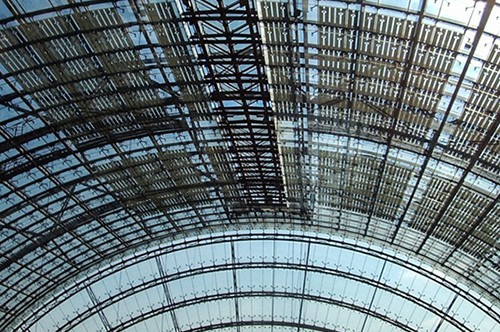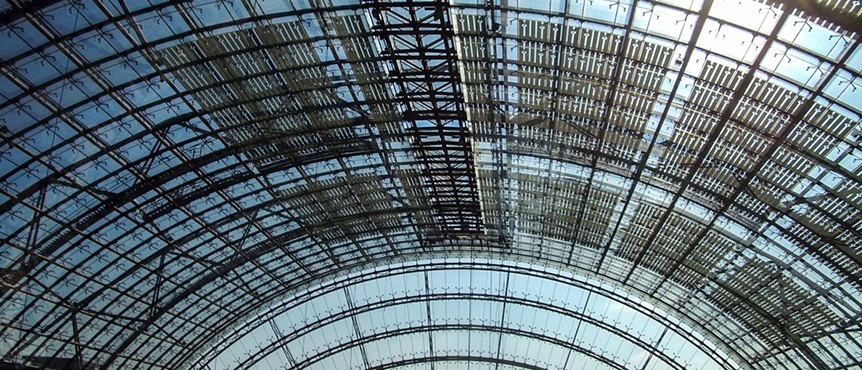As Mexico's construction sector is increasingly using steel, a higher quality and more flexible material than concrete.


In the center of Mexico lies the Bajío, a lowland region northwest of Mexico City. It has established itself, quite literally, as the motor of Mexico’s economy, being home to much of Mexico’s highly competitive automotive, aerospace, home appliance and wider manufacturing industries. These industries’ growth has led to a building boom in places like Querétaro where the construction industry grew by 28.5% in 2017, driven in particular by investments in public works.
Grupo Ameristeel, which designs and assembles steel structures, has seen robust growth from the middle-income and above housing market in this region, reflecting the increasingly highly-skilled nature of the Bajío’s labor force. “We are experiencing most demand in Querétaro and the wider Central Mexico region including Mexico City and up to Guadalajara,” commented Juan Pedro Martín Navarro Cota, founder of Grupo Ameristeel.
Along with other construction services companies such as Estructuras Solana, Ameristeel is also experiencing solid demand from Central America, in particular from Panama.
All is not Well
Construction is a big deal to the Mexican economy, representing 8% of overall GDP and accounting for 15.7% of its overall workforce. However, whilst construction in the Bajío is buoyant, at a national level the construction industry is somewhat subdued. According to the National Institute of Statistics and Geography (INEGI), whilst construction growth was 2.6% in 2015 and 1.8% in 2016, in the twelve months to November 2017 average monthly construction growth in output averaged -1.5%.
A key determinant of demand has been government spending. In 2014, President Peña Nieto’s government announced the National Infrastructure Plan for 2014-2018, which pledged to spend US$596.2 billion across six sectors: communications and transport, energy, water, health, urban development and housing, and tourism. However, the government has had to cut back its planned investments as it implements fiscal austerity measures due to falling oil prices. Private investment has picked up some of the slack but the government’s retreat has left market sentiment depressed.
Nevertheless construction companies are optimistic that developments are moving in their favor, with reconstruction after the 2017 earthquakes, the construction of the New International Airport for Mexico City (NAICM) and the government’s special economic zones policy all expected to drive demand. “The new airport is the most emblematic project from the current administration. Due to the size of the investment it represents a huge opportunity for the steel, construction, aluminum and glass industries,” remarked Jose Luis Vargas, general director, Harsco Industrial IKG, which makes steel grating and security fences and supplied the 32 km security fence at the airport’s construction site.
Steel Got It
The strength of the construction sector is very important for the steel industry given that it accounts for 61.5% of steel usage. With drivers of the sector pointing in different directions, one would expect steel demand from it to be restrained. However, according to Maria Cristina Frías, general director of Fabrestructuras which designs, fabricates and erects steel structures: “Ten years ago, about 15% of the buildings in Mexico were made of steel, but that number has since risen to at least 25%. We believe this growth will be sustainable over the next five to 10 years.”
40% of US buildings are made from steel and Mexico is moving towards that ratio as well. As Mexico becomes richer, it is demanding the use of higher quality and more versatile materials like steel and iron in place of concrete. Frías puts it succinctly: “Simply put, buildings constructed with steel are always higher quality than those constructed with concrete. Steel is also easier to work with and, therefore, more flexible.”
This trend will be boosted by the effects of the earthquakes as Mexico’s public demands more seismic resilient buildings. “One of the greatest lessons of last year’s event is that the materials of the works have to be durable and sustainable,” insisted Fernando Gutiérrez, president of the Mexican College of Civil Engineers (CICM).
The need for reconstruction after the devastation caused by the earthquakes is urgent and steel is well suited to such an exigency. As Pablo Solana, operations director of Estructuras Solana and president of the Mexican Institute of Steel Construction (IMCA) commented: “Steel construction is much faster than concrete construction”.
Steel has a reputation for being more expensive than concrete but this is not always the case and, in the long run, it may be cheaper to use. Solana continued: “The faster you complete a project, the faster you get income. Therefore, steel construction has many benefits that make it the right choice economically… Any building taller than four stories should be constructed with steel because the design is much easier and the structures are safer.”
With Mexico’s steel production breaching records and its advantages laid bare after the earthquakes, steel’s popularity in construction will continue to grow. Navarro Cota certainly agreed: “Steel has very good ductility which we must be thankful for in particular in a seismic country like Mexico. In this regard, it is the best material ever. We are in love with it.”

In the center of Mexico lies the Bajío, a lowland region northwest of Mexico City. It has established itself, quite literally, as the motor of Mexico’s economy, being home to much of Mexico’s highly competitive automotive, aerospace, home appliance and wider manufacturing industries. These industries’ growth has led to a building boom in places like Querétaro where the construction industry grew by 28.5% in 2017, driven in particular by investments in public works.
Grupo Ameristeel, which designs and assembles steel structures, has seen robust growth from the middle-income and above housing market in this region, reflecting the increasingly highly-skilled nature of the Bajío’s labor force. “We are experiencing most demand in Querétaro and the wider Central Mexico region including Mexico City and up to Guadalajara,” commented Juan Pedro Martín Navarro Cota, founder of Grupo Ameristeel.
Along with other construction services companies such as Estructuras Solana, Ameristeel is also experiencing solid demand from Central America, in particular from Panama.
All is not Well
Construction is a big deal to the Mexican economy, representing 8% of overall GDP and accounting for 15.7% of its overall workforce. However, whilst construction in the Bajío is buoyant, at a national level the construction industry is somewhat subdued. According to the National Institute of Statistics and Geography (INEGI), whilst construction growth was 2.6% in 2015 and 1.8% in 2016, in the twelve months to November 2017 average monthly construction growth in output averaged -1.5%.
A key determinant of demand has been government spending. In 2014, President Peña Nieto’s government announced the National Infrastructure Plan for 2014-2018, which pledged to spend US$596.2 billion across six sectors: communications and transport, energy, water, health, urban development and housing, and tourism. However, the government has had to cut back its planned investments as it implements fiscal austerity measures due to falling oil prices. Private investment has picked up some of the slack but the government’s retreat has left market sentiment depressed.
Nevertheless construction companies are optimistic that developments are moving in their favor, with reconstruction after the 2017 earthquakes, the construction of the New International Airport for Mexico City (NAICM) and the government’s special economic zones policy all expected to drive demand. “The new airport is the most emblematic project from the current administration. Due to the size of the investment it represents a huge opportunity for the steel, construction, aluminum and glass industries,” remarked Jose Luis Vargas, general director, Harsco Industrial IKG, which makes steel grating and security fences and supplied the 32 km security fence at the airport’s construction site.
Steel Got It
The strength of the construction sector is very important for the steel industry given that it accounts for 61.5% of steel usage. With drivers of the sector pointing in different directions, one would expect steel demand from it to be restrained. However, according to Maria Cristina Frías, general director of Fabrestructuras which designs, fabricates and erects steel structures: “Ten years ago, about 15% of the buildings in Mexico were made of steel, but that number has since risen to at least 25%. We believe this growth will be sustainable over the next five to 10 years.”
40% of US buildings are made from steel and Mexico is moving towards that ratio as well. As Mexico becomes richer, it is demanding the use of higher quality and more versatile materials like steel and iron in place of concrete. Frías puts it succinctly: “Simply put, buildings constructed with steel are always higher quality than those constructed with concrete. Steel is also easier to work with and, therefore, more flexible.”
This trend will be boosted by the effects of the earthquakes as Mexico’s public demands more seismic resilient buildings. “One of the greatest lessons of last year’s event is that the materials of the works have to be durable and sustainable,” insisted Fernando Gutiérrez, president of the Mexican College of Civil Engineers (CICM).
The need for reconstruction after the devastation caused by the earthquakes is urgent and steel is well suited to such an exigency. As Pablo Solana, operations director of Estructuras Solana and president of the Mexican Institute of Steel Construction (IMCA) commented: “Steel construction is much faster than concrete construction”.
Steel has a reputation for being more expensive than concrete but this is not always the case and, in the long run, it may be cheaper to use. Solana continued: “The faster you complete a project, the faster you get income. Therefore, steel construction has many benefits that make it the right choice economically… Any building taller than four stories should be constructed with steel because the design is much easier and the structures are safer.”
With Mexico’s steel production breaching records and its advantages laid bare after the earthquakes, steel’s popularity in construction will continue to grow. Navarro Cota certainly agreed: “Steel has very good ductility which we must be thankful for in particular in a seismic country like Mexico. In this regard, it is the best material ever. We are in love with it.”